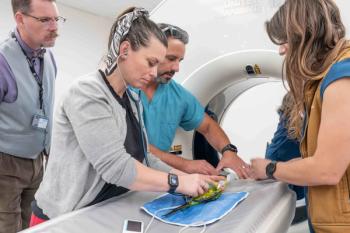
Bone appetit: an appetizer of developmental orthopedic radiology (Proceedings)
Osteochondritis dissecans (osteochondrosis dissecans, OC, OCD) is the most common of the developmental orthopedic diseases and is caused by a sub-condral ossification defect that results in increased thickness of soft articular cartilage, thus decreased nutrient and oxygen availability (from articular fluid) and secondary mechanical failure resulting in a concave bony defect and cartilage flap formation.
Osteochondritis dissecans (osteochondrosis dissecans, OC, OCD) is the most common of the developmental orthopedic diseases and is caused by a sub-condral ossification defect that results in increased thickness of soft articular cartilage, thus decreased nutrient and oxygen availability (from articular fluid) and secondary mechanical failure resulting in a concave bony defect and cartilage flap formation. The cartilaginous flap will often mineralize and be found in the joint space (a joint mouse). This is seen most commonly in large and giant breed dogs and is more common in males versus females. It is seen most often in dogs 4-10 months of age and may be bilateral. Radiographic signs include a small to large flattened or concave area on caudal aspect of the humeral head sometimes with a flap lesion in joint. This flap may be found in the caudal or cranial joint pouch. Sclerosis of the sub-condral bone is identified as increased opacity of the bone deep to the articular defect. Secondary degenerative joint disease is noted as periarticular osteophytes are seen surrounding the joint. Joint effusion is typical and often pronounced. There are numerous sites that osteochondrosis can be found. The most common is the humeral head. Other sites which may have OC lesions are the medial condyle of distal humerus, the medial or lateral styloid process of fibula, condyles of femur (lateral in large dogs most common), the trochlear ridge of talus (common in Rotweillers and Labradors), and the glenoid of the scapula. Animals will present with varying degrees of lameness from intermittent slight lameness to severely lame.
Fragmented medial coronoid process (FCP) of the ulna is part of the elbow dysplasia complex and its cause is not completely determined. It is a relatively common disease. It may be a form of OCD, may be heritable, and may be due to elbow joint incongruity. Large breed dogs and Shelties develop this disease. It is again seen in young dogs 4-10 months of age and even despite unilateral lameness is most often bilateral. The lameness can be intermittent or the patient can present with a stiff gait. Radiographic signs include a flattened, ill defined or concave appearance of the medial coronoid process with bony sclerosis of the ulnar trochlear notch, osteophytes on the anconeal process and on the radial head and less often or minor joint effusion. "Kissing lesions" on the adjacent medial humeral condyle can be detected. Some believe this is really on accompanying OC lesion of the humeral condyle. It is important to realize that visualization of the actual bone fragment on lateral or cranial to caudal view is rare. The animal "warms' out of the lameness with exercise. Flexed lateral view best to see fragmented medial coronoid process. Hyperflexed lateral view shows early or mild osteophytes on the ulnar anconeal process. Given the complex three dimensional anatomy of the elbow, CT has been proven to be the best way to confirm a diagnosis of fragmented medial coronoid process.
An ununited anconeal process has an unknown underlying etiology though joint incongruity (due to premature closure of distal ulnar physis), hereditary factors, and trauma during development have all been hypothesized. The anconeal process arises from a separate center of ossification and normally fuses at about 5-6 months of age. Therefore diagnosis before normal fusion of the physis is not possible. Medium to large breed dogs (German shepherds are over-represented) with an age range between 5-10 months are affected. The disease may be bilateral. Roentgen findings include a radiolucent line separating the proximal anconeal process from the rest of the ulna. Degenerative joint disease of the elbow joint is often severe. A hyperflexed lateral view is best to diagnose this abnormality as it moves the medial humeral condyle proximally so it is not superimposed with the anconeal process.
Retained cartilaginous core in the ulna has an unknown etiology. It is common in giant breed dogs (especially Great Dane's) that are less than 2 years of age. These patients are usually asymptomatic. In rare cases may cause pain or result in asynchronous growth of radius and ulna. A conical shaped area of radiolucency in noted in the distal ulnar metaphyseal region. This is due to hyaline cartilage within the distal ulnar metaphysic. Normal Great Dane puppies have retained cartilage cores in their distal ulnar metaphyses between 15-21 weeks of age.
Panosteitis also does not have a known cause. It affects young (less than 2 years) medium to large breed dogs, especially German Shepherds. However it can also happen on older dogs! The classic presentation is a shifting leg lameness that may be mild to severe. Early on the radiographic findings can be minimal with ill defined regions of increased medullary opacity. More mature lesions appear as sharply marginated increased intramedullary opacity in the diaphyseal portions of long bones, often around the nutrient foramen. This causes the endosteal surface of the long bone to become less defined. Non-aggressive smoothy marginated periosteal reaction or cortical thickening can be seen in advanced cases. The abnormal bone deposits are predictable located in the distal aspect of the humeral shaft, distal femoral shaft, proximal radius and ulna and proximal tibia. Once the disease subsides the described lesions gradually disappear over the next few months. Panosteitis is typically self limiting and will completely resolve over time. Treatment includes anti-inflammatories, pain medications, and rest. Some patients become so painful that they cannot walk and require intensive treatment.
Hypertrophic osteodystrophy (HOD and metaphyseal osteodystrophy). The etiology of hypertrophic osteodystrophy (HOD) is uncertain. Both a viral infection and possibly nutritional causes have been hypothesized. Large breed dogs between 4 and 10 months of age are affected. There is no sex predilection. The animal can be moderately to extremely painful, febrile, and have pain on palpation of the distal antebrachial region. Radiographically there is an ill-defined radiolucent line parallel to the physis causing a "double physeal" appearance. The metaphyseal side of the growth plate is affected. The radiolucent line is necrotic bone. Physeal "flaring" may be noted as well, which appears as lacy bone production around the growth plate. This may progress in severe cases to a layered type periosteal reaction extending up the diaphysis. The distal radius, ulna and tibia are commonly affected. Usually the lesions are symmetrically distributed throughout the forelimbs and hindlimbs. Most dogs recover regardless of treatment. The metaphyseal bone deposition subsides and the bones slowly resume their original shapes. Some affected puppies develop bilateral valgus deformities in their mid and distal forelimbs.
Newsletter
From exam room tips to practice management insights, get trusted veterinary news delivered straight to your inbox—subscribe to dvm360.






